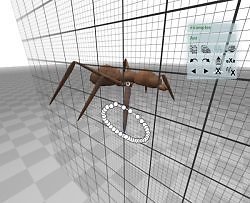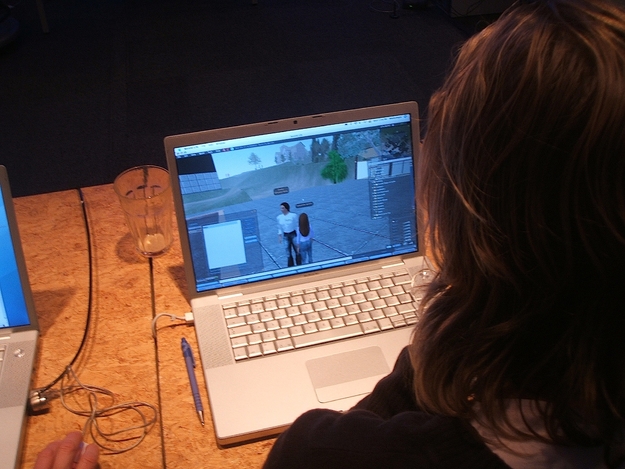Coaches and Participants
Led by excellent coaches Friedrich Kirschner, Julian Oliver and Jonas Hielscher, this workshop Games-in-Crossmedia tried to solve these issues for its participants.
Participants to this workshop were game researchers, media makers from TV and newer media as well as mobile game entrepeneurs. Their process followed two opposed directions that met halfway.
Participant in Workshop Experimenting
The First Approach
One workshop track went from the inside of game technology outward. Along this track we explored the possibilities for creative play with game technology for other purposes than just gaming. Game technology is very accomplished, extremely flexible and totally ready to be explored and exploited in endless new media contexts, also because many contemporary games come with their own designing tools. Can musical instruments be built with a game engine? Sure, demonstrated lecturer Daniel van Gils. Can you make theatre in game spaces? Indeed, showed Bas Haas' SecondLife project, and even the audience knows exactly how to behave. Can you blend in-game recorded images with video footage made in the real world? Participants Menno and Oscar Grootveld explored the possibilities and came up with a small documentary on a World of Warcraft troll that had to see a therapist, and ultimately joins the Alliance.
An other excellent demonstration was provided with Julian Oliver's project Levelhead. As you can see a little computer generated man is trapped in a small wooden cube in your hand. By tilting the cube you give him directions, and help him to find the way out. Computer generated imagery is edited in realtime into live video, with near magical effects.
The Second Approach
The other workshop strand started outside game culture, and worked its way in. This was about opening up game design and development to other media practices. Lecturer and participant Valentina Rao in her presentation provided a short analysis of of what effective crossmedia practices boil down to: transmedial worlds or transmedial characters, that can be engaged with through various media channels. She pointed out that there is one successful game genre that is crossmedial by nature - Alternate Reality Games (ARG's) although they don't typically use 3D game technology. Participant Tomas Karminskas (LIT) developed an idea for a crossmedial character that was inspired by the garden gnome from Le Fabuleux destin d'Amélie Poulin. This character could live on all your media apparatuses and can appear on your pictures, prints, and even in games you play. This project was partly a reaction to the notion that most games are separate worlds, that on a narrative and experiential level do not blend well with other story worlds.
Other questions that came up in this strand were: How can gaming be televised in ways that is equally intriguing (or even just understandable) to non-gamers? Should broadcasters of children television start working in game spaces as well? What do educators need to know to speak 'game culture' so that their game projects not only look interesting to adult non-gamers but are appealing to your target group of teen gamers as well?
Participants Rachel de Wit (NL) and Ilse Godtschalk (NL) developed an educational space inside Second Life. Here resided a game character that had previously been an extra figure in Quake3 and 4, as a masked sniper in CounterStrike, and as common grunt in several Doom editions, but that had now decided on a change in his life. He had become sick of the everyday violence in his existence, and now coached children and adolescents, teaching them how to deal with violence in games.
This exciting and very insightful workshop still only scratched the surface of the seemingly endless possibilities. Therefore be sure to look out for upcoming Mediamatic workshops on game technology in wider contexts.

